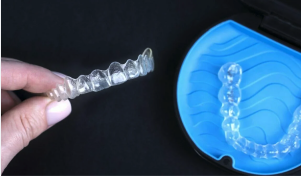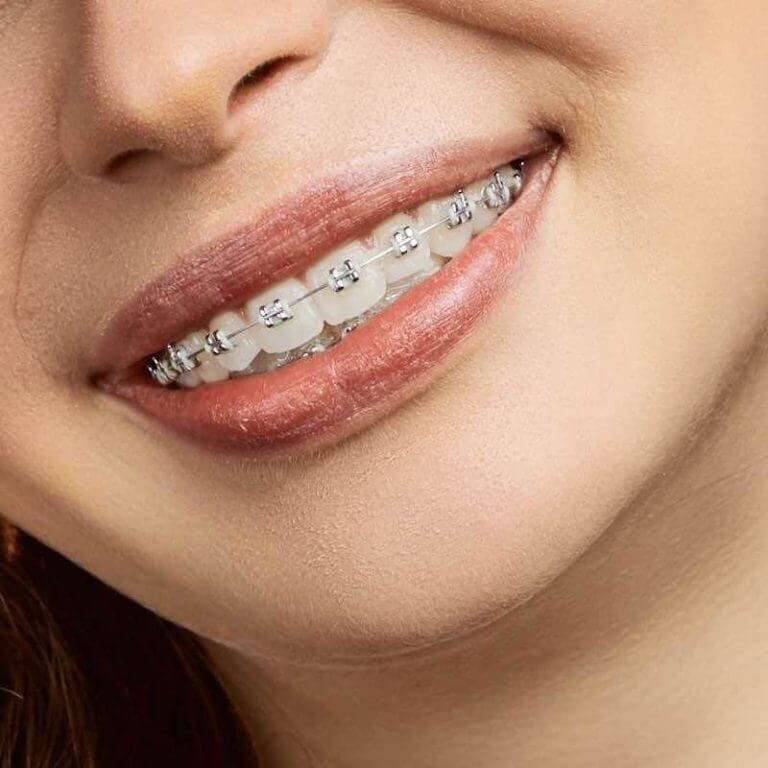Today, orthodontic patients can choose from a range of metal or ceramic options (not to mention clear aligners).
While this is undoubtedly a positive, allowing for greater personalisation of care, we understand it can also be a little confusing for patients. That’s why we’ve created this guide to help you understand the pros and cons of metal and ceramic braces.
Ceramic Braces: The Pros & Cons

However, orthodontic treatment is becoming increasingly popular among adults. A 2018 report from the British Orthodontic Society found that 80% of members were seeing an increase in adult patients, up from 75% in 2016.
This is almost certainly related to the growing availability of clear braces, of which ceramics are one of the most popular options. Read on for the main pros and cons of ceramic braces:
Pros:
More Aesthetically Pleasing
Ceramic braces are often favoured by adult orthodontic patients because they are less noticeable than metal alternatives. They are made from translucent materials; some options even include tooth-coloured wires to make them even more discreet. This can make a big difference. According to research, people are more likely to feel insecure about their teeth than any other physical trait, apart from weight. With that in mind, it’s little wonder that people – particularly adults – are keen to choose braces that are almost invisible.
Less Painful
Orthodontic patients generally find ceramic braces more comfortable to wear than metal ones. The high-quality materials aren’t abrasive, so they won’t irritate your gums or the sides of your mouth (a common complaint for metal brace wearers). After wearing ceramic braces for a few weeks – typically two to four – you shouldn’t feel any pain at all.
Cons:
Often More Expensive
There’s no getting away from the fact that ceramic braces are almost always a more expensive option than metal braces. This is largely down to the higher-quality materials used, but it’s also worth noting that in some cases, ceramic braces may take longer to achieve the desired results. This naturally has an impact on cost too.
May be less Effective for Dramatic Changes to Teeth Structure
While ceramic braces are suitable for the majority of orthodontic patients, in extreme scenarios – where major changes are required to the structure of the teeth – they may be less effective than metal ones. Book a free consultation at our Liverpool city centre clinic if you want our help in assessing whether ceramic braces are suitable for your needs.
Metal Braces: The Pros and Cons

Despite the growing prominence of clear alternatives, metal braces remain the most common option. They are most often worn by children – particularly those being treated as NHS patients – but are also favoured by some adults requiring orthodontic treatment.
Aside from cost (they’re almost always going to be the cheapest option, as detailed above), here are the biggest advantages and disadvantages of metal braces:
Pros:
Strong and Durable
Given the strength of the materials involved, metal braces are highly durable and offer excellent control.
The downside of this is that metal braces are more likely to cause discomfort, while the materials also – inevitably – leave you with a metallic taste in your mouth.
Less Likely to Show Discolouration
As they’re made from darker materials, metal braces are less likely to become discoloured.
This can be an issue with ceramic braces, although it can be overcome through brushing after every meal, using floss and mouthwash, and cutting out red and yellow-coloured foods like mustard and tomatoes.
Cons:
Much More Noticeable
Just as the cost is the most obvious downside of ceramic braces, there’s no avoiding the aesthetic impact of metal braces – they’re just very noticeable. However, they are smaller and more comfortable than they used to be, and you’ll generally be offered a range of colour options for the bands that secure the wires to the brackets.
Harder to Clean
Given their chunkier size, metal braces make it harder for you to maintain good oral health. In extreme circumstances, or if left unchecked, this can lead to complications such as gum disease and gum recession.
Which Option is Best for you?

When it comes to choosing between metal and ceramic braces, the best option will very much depend on circumstance – both in terms of the treatment required and also the cost. As an added complication, you might find that removable aligners are the best fit for your requirements.
As ever, we want to help. Book a free consultation to run through your treatment options with our friendly and experienced team.

